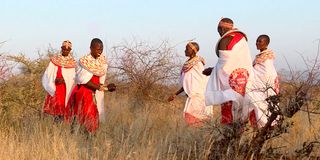Samburu women protecting lions for the good of ecosystem

Mama simba women harvesting seeds from the grass they planted in Samburu.
As the world wobbles from the effects of climate change, communities that were hitherto peacefully coexisting with wildlife are now finding themselves at loggerheads with the animals as spaces between continue to shrink.
The growing incidents of human-wildlife conflict have been a major concern, pushing conservationists to device ways of ensuring the two species coexist peacefully.
Samburu community, one of the Kenyan communities with a vibrant and rich culture, has faced these challenges head-on. Jenerea Lekilelei, director of Community Conservation-Ewaso Lions, says, “the link between the Samburu and wildlife is the fact that they believe the elephants are their ancestors and when lions roar it is a sign of hope to the community.”
The community prides itself in livestock keeping, a source of wealth and culture. But now the grazing land, which is shared by livestock and wildlife, is shrinking; resulting in human-wildlife conflict.
This led to the founding of Ewaso Lions in 2007 by Shivani Bhalla with a mission to promote co-existence between lions and humans and provide a safe haven for the lions in the region. Growing up, Jenerea was not a fan of lions. The notion, however, changed when he started spending more time understanding them.
“I love lions. They are social just like us. They live in large prides just like our families and they take care of their cubs just like our mums,” he says.
But the number of lions across Africa is on the decline and their population is under threat. The population has declined by 43 per cent in the last 20 years in Africa.
There are only about 20,000 lions left on the continent and less that 2,500 roam in Kenya. This is as a result of habitat loss, climate change and human wildlife conflict.
Lions are critical because they help balance the ecosystem and attract tourists.
In the Samburu community, it is believed that wildlife belong to women.
In Sasaab village, women sit under trees to learn how to read and write about the importance of lions.
The members of Mama Simba women’s group acquire and apply knowledge and skills to spread conservation messages to other communities about co-existing with wildlife.
They also plant grass for animals to feed on. Munteli Lalparasaroi, a member of Mama Simba group, says: “The problem we have here is drought, when there is no grass, lions, elephants and livestock die, but when we have the grass, the food chain will be complete. Herbivores will have food and thus lions too. Our livestock will be safe from predators and have food as well.”
The women say they are committed to be part of the solution in mitigating climate change and protecting the 60 lions in the Ewaso Ng’iro ecosystem.
Francis Lendorop, a village elder, says “when we were morans, the rains were predictable, but now we can’t tell when the rains will come and we are losing livestock every season. During that time, you could see many warthogs in the park and lions had food in plenty. Today, spotting even 10 warthogs is a challenge. Drought has led to human-wildlife conflict. It is hard to explain to the community why we still need to conserve the lions but we are hopeful.”




